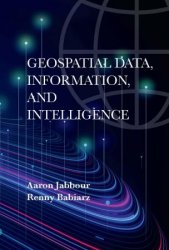 Название: Geospatial Data, Information, and Intelligence
Название: Geospatial Data, Information, and IntelligenceАвтор: Aaron Jabbour, Renny Babiarz
Издательство: Artech House
Год: 2023
Страниц: 251
Язык: английский
Формат: pdf (true)
Размер: 10.2 MB
This book provides practitioners with structured methods for transforming geospatial data into the useful information they need to solve some of the world's most pressing problems. It spotlights the importance of location for human experience in the everyday world and introduces spatial thinking as a foundation and the location mindset as a foundational perspective. The book starts by showing how geospatial analysis is part of a more general data-to-information refinement process that requires the right mindset, toolset, and skillset to achieve. The book then presents structured principles and practices to help geospatial analysts--whether in government or industry--improve their observational, analytical, and communication techniques. These techniques are part of an original framework for interpreting geospatial data and information: the Observe, Analyze, Communicate (OAC) Framework. The OAC framework helps practitioners at all levels break down the basic steps of their day-to-day practice and learn valuable tradecraft that they can employ during each step. You'll learn how to center location as a foundational perspective in everyday life; use unique geospatial observation, analysis, and communication techniques; and know how to account for the role of uncertainty in assessment and production processes -- including utilizing special techniques to effectively communicate levels of certainty and uncertainty to your audience.
You'll also understand how pairing visual information with precise locational information serves to anchor human attention and provides an antidote to the common problem of disorientation. The book reveals specific techniques and tradecraft that will greatly benefit all practitioners working with visual and locational information. One such tradecraft called Structured Geospatial Observation Techniques (SGOT) includes a technique called the Four Cornerstones that will allow you to structure your approach to visual data and extract more attribute and contextual data from your object of focus. Another technique reveals industry and government-gleaned tips and tricks to creating finished geospatial communications in paragraphs, products, and presentations.
Locations are widely available to laypeople and practitioners alike. Practitioners can collect locations from people who provide them during conversations and debriefings. People can extract locations from sensors that recently collected them during field research. One can collect geospatial locations in tabular datasets that can then be visualized in a GIS. This data can be improved through the application of additional attributes, which are the fields of data attributed to locations that provide context. Practitioners can also download locations from open data websites that offer the public municipal, legal, and public safety information. Employees can access locations by querying their organization’s systems for detailed reports of recent incidents. Photographs and videos from security cameras, cell phones, and digital cameras are widely available in various media. Indeed, everyone with computer or smartphone access can view and interact with publicly available mapping and imagery interfaces that allow users to hover over a location and click to access the corresponding geographic coordinates. These geo-enabled interfaces are universally available on the internet and even allow users to conduct rudimentary geospatial analysis.
Bringing together the authors' combined 30 years of experience with geospatial intelligence (GEOINT), this book is a must-have practical resource for students, faculty, and practitioners of geospatial endeavors at any level of experience, especially fields that use imagery and spatial analysis. It serves as a textbook for classroom beginners and as a go-to desktop reference for professionals in their day-to-day geospatial efforts.
Скачать Geospatial Data, Information, and Intelligence